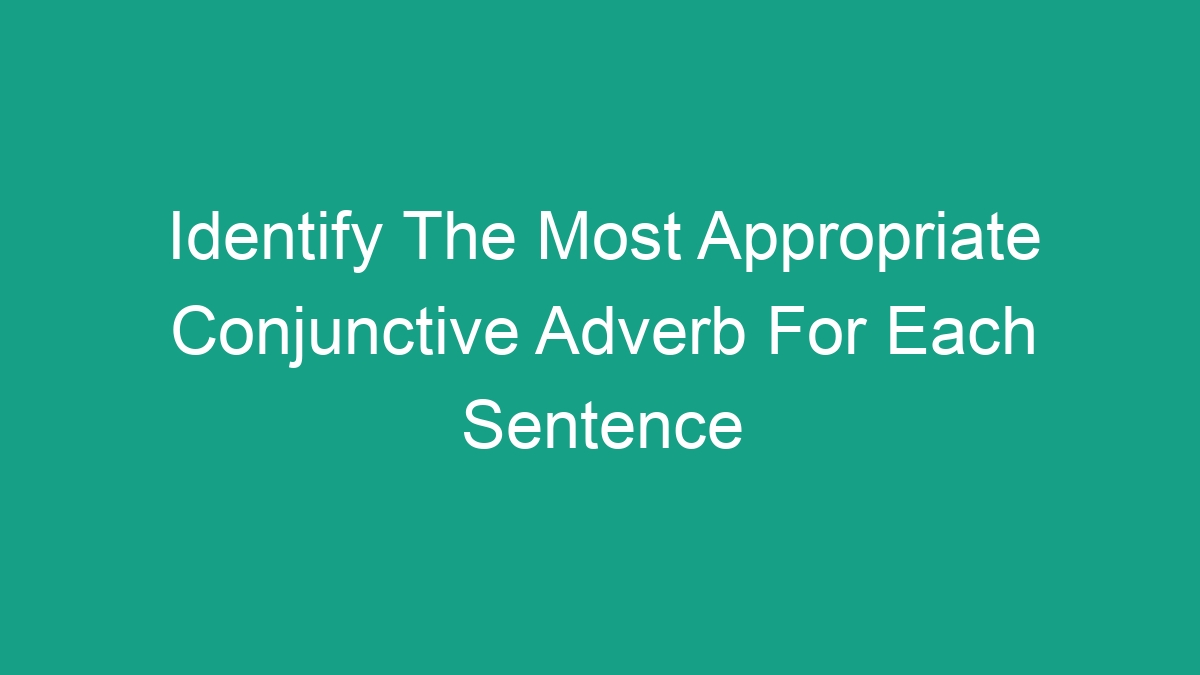
Introduction
Conjunctive adverbs are connecting words that are used to link different parts of a sentence or different sentences. They are essential in creating smooth and logical transitions within a piece of writing. When used correctly, conjunctive adverbs can enhance the overall flow and coherence of a text. However, choosing the most appropriate conjunctive adverb for a particular sentence can be challenging for many writers. In this article, we will explore the various types of conjunctive adverbs and provide examples to help you identify the most suitable conjunctive adverb for each sentence.
Understanding Conjunctive Adverbs
Conjunctive adverbs serve as connectors in a sentence, linking independent clauses or indicating a relationship between ideas. They can also show cause and effect, contrast, sequential order, or emphasize a particular point. Some common conjunctive adverbs include “however,” “therefore,” “moreover,” “meanwhile,” “nevertheless,” and “furthermore.” When choosing the right conjunctive adverb for a sentence, it is important to consider the specific relationship or transition you want to convey.
Identifying the Most Appropriate Conjunctive Adverb
1. Explaining Cause and Effect: When you want to show cause and effect in a sentence, you can use conjunctive adverbs such as “therefore,” “thus,” or “consequently.” For example:
– She studied hard; therefore, she scored well on the exam.
– The weather was bad; consequently, the flight was delayed.
2. Contrasting Ideas: If you want to express a contrast or contradiction, you can use conjunctive adverbs like “however,” “nonetheless,” or “on the other hand.” For example:
– She wanted to go to the party; however, she had too much work to do.
– The movie received mixed reviews; nonetheless, it was a box office success.
3. Adding Information: When you want to add more information or emphasize a point, you can use conjunctive adverbs such as “furthermore,” “moreover,” or “in addition.” For example:
– The restaurant served delicious food; moreover, the service was excellent.
– She excels in academics; in addition, she is also a talented musician.
4. Indicating Sequence: If you want to show the sequence of events in a sentence, you can use conjunctive adverbs like “meanwhile,” “subsequently,” or “then.” For example:
– She finished her work; meanwhile, her colleagues continued with their tasks.
– He missed the bus; subsequently, he arrived late for the meeting.
5. Emphasizing: When you want to emphasize a point or add emphasis to a sentence, you can use conjunctive adverbs such as “indeed,” “certainly,” or “undoubtedly.” For example:
– She is indeed a dedicated employee.
– His efforts have certainly paid off.
Common Mistakes When Using Conjunctive Adverbs
While conjunctive adverbs can be a valuable addition to your writing, there are common mistakes that writers make when using them. Here are a few of these mistakes and how to avoid them:
1. Overusing conjunctive adverbs: It’s important not to overuse conjunctive adverbs in your writing. Using them too frequently can make your writing feel clunky and repetitive. Instead, aim to use them sparingly and only when necessary to enhance the flow and coherence of your sentences.
2. Incorrect placement: Conjunctive adverbs should be placed at the beginning, middle, or end of a sentence, depending on the context. It’s crucial to ensure that they are placed in a way that effectively connects ideas and maintains the flow of the text.
3. Incorrect punctuation: When using conjunctive adverbs to connect two independent clauses, it’s essential to use the appropriate punctuation. A semicolon or a comma, followed by a conjunctive adverb, is typically used to connect the clauses.
Improving Your Writing with Conjunctive Adverbs
When used effectively, conjunctive adverbs can significantly improve the clarity and coherence of your writing. By carefully selecting the most appropriate conjunctive adverb for each sentence, you can create seamless transitions between ideas and enhance the overall flow of your writing. Here are a few tips for improving your writing with conjunctive adverbs:
1. Consider the relationship between ideas: Before choosing a conjunctive adverb, consider the relationship between the ideas you want to connect. Are you showing cause and effect, contrasting ideas, adding information, indicating sequence, or emphasizing a point? This will help you select the most suitable conjunctive adverb for the context.
2. Review and revise: After incorporating conjunctive adverbs into your writing, be sure to review and revise your sentences to ensure that they flow smoothly and logically. Pay attention to the placement of the conjunctive adverbs and the punctuation used to connect clauses.
3. Seek feedback: If you’re unsure about the effectiveness of conjunctive adverbs in your writing, seek feedback from peers, colleagues, or professional editors. Their insights can help you refine your use of conjunctive adverbs and improve the overall quality of your writing.
4. Read and analyze: Reading widely and analyzing how other writers use conjunctive adverbs can provide valuable insights for improving your own writing. Pay attention to how they seamlessly integrate conjunctive adverbs to create cohesive and coherent sentences.
Conclusion
In conclusion, conjunctive adverbs play a crucial role in connecting ideas and enhancing the overall coherence of your writing. By identifying the most appropriate conjunctive adverb for each sentence, you can effectively convey relationships, transitions, and emphasis within your writing. Avoiding common mistakes and following best practices for using conjunctive adverbs can help you improve the quality and impact of your writing. With careful consideration and practice, you can master the art of using conjunctive adverbs to create clear, cohesive, and compelling sentences.



